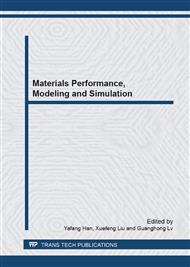[1]
N. Huang, S. Ye, Z. Fan, Principles and Quality Control of LFC, Hubei, (2004).
Google Scholar
[2]
G. Sun, H. Liao, Y. Pan, Fabrication Processes and Control of Interfacial Reaction of Particulate Reinforced Metal Matrix Composites, Special Casting & Nonferrous Alloys, 4 (1998) 12-17.
Google Scholar
[3]
S. Yin. Combustion Synthesis, Beijing, (1999).
Google Scholar
[4]
L. Cheng, Y. Dong, Liquid Phase Sintering of High-carbon and High-alloy Iron-based Materials, Powder Metallurgy Technology, 16 (1998) 195-198.
Google Scholar
[5]
FHA Writing Group, Foreign Hard Alloy, Beijing, (1976).
Google Scholar
[6]
D. Ye, J. Hu. Functional Manual of Inorganic Thermodynamic Data, second ed., Beijing, (2002).
Google Scholar
[7]
J. Li, The Self-propagating Combustion Reaction in Ti-W-C Syetem and its Application in Cemented Carbide, Hunan, (2000).
Google Scholar
[8]
M.J. Mas-Guindal, et al., Self-propagating High-temperature Synthesis of TiC–WC Composite Materials, Journal of Alloys and Compounds, 419 (2006) 227-233.
DOI: 10.1016/j.jallcom.2005.08.079
Google Scholar
[9]
Y. Yan, et al., effects of technological parameters of TiC-Fe cermet graded composite coating on cast substrate by SHS-casting route, the Chinese Journal of Nonferrous Metals, 13 (2003) 157-161.
Google Scholar
[10]
C. Ji. Technology of Preparing TiC/Fe Surface Composite of Steel Castings by SHS in Process of Pouring, CHINESE JOURNAL OF RARE METALS, 28 (2004) 9-12.
Google Scholar
[11]
X. Liu, et al., Microstructure of In-Situ TiC Particles Reinforced Steel Matrix Surface Composites Prepared by V-EPC, CHINA FOUNDRY, 58 (2009) 341-343.
Google Scholar
[12]
W. Chen, et al., Study on Wear-resistant Property of TiCNi/Fe Ceramic Coating Produced by SHS Reactive Hot Pressing, HOT WORKING TECHNOLOGY, 38 (2009) 89-92.
Google Scholar
[13]
Y. Cheng, et al., the effect of ferro-titanium addition on surface qualities andmicrostrutures of particles reinforced 45 cast steels matrix composites. Journal of Inner Mongolia University of Science and Technology, 29 (2010) 23-28.
Google Scholar
[14]
B. Chen. Preparing of TIB2–TiC Composite Materials by SHS, Ningxia Engineering Technology, 3 (2004) 160-162.
Google Scholar
[15]
Y. Wang, et al., study on the structure and properties of TIB2–TiC multiphase ceramics. ACTA MATERIAE COMPOSIT AE SINICA, 20 (2003) 22-26.
Google Scholar
[16]
Z. Zhang, Fabrication of TiC-TiB2 locally Reinforced Low Cr Steel Matrix Composite Using a Fe-Ti-B4C System by SHS-Casting Route, Jilin University, (2006).
DOI: 10.1007/s10853-006-0764-6
Google Scholar


